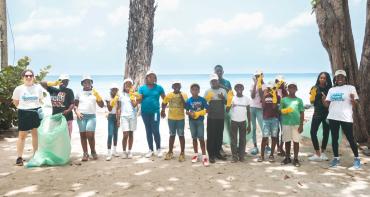The Commonwealth Blue Charter is highlighting case studies from the Commonwealth and beyond, as part of a series to spotlight best practice successes and experiences.

Share your own case study with us
“Fishermen catches have once declined nearshore before the arrival of CBFM in 2014. The creation of management plans brought in positive impacts to our marine resources and fishermen are getting more catches now than before.”
– Biita Ioane, Kuma fisherman from Butaritari
Summary
The coastal fisheries of Kiribati are typically artisanal and local. Rapid population growth has increased pressure on these resources, as evidenced by declines in abundance of target species such as goatfish, clams and bonefish.
In 2013, the Government of Kiribati made Community Based Fisheries Management (CBFM) a short-term priority strategic action in its National Fisheries Policy. This was followed, in 2014, by a three-year pilot project on CBFM focusing on two islands, North Tarawa and Butaritari, as a partnership between the Ministry of Fisheries and Marine Resource Development of Kiribati (MFMRD), the University of Wollongong (Australian National Centre for Ocean Resources and Security– ANCORS) and the Pacific Community (SPC), with funding from the Australian Centre for International Agricultural Research (ACIAR). There were four phases to the work: scoping threats and opportunities, identifying stakeholders and how they wished to manage their fishery, developing management plans, and monitoring and evaluation.
Five communities took part in the pilot project; over the three years, all of them produced CBFM plans. These are supported by the Island Council and elders association promoting measures such as banning the use of destructive fishing gears and practices. Legal backing is planned under the recently agreed Fisheries (Conservation and Management of Coastal Marine Resources) Regulations 2019.
Data-gathering through community meetings has improved knowledge across different stakeholder groups of fisheries resources and their sustainable exploitation. This work has been supported with training for community members and MFMRD staff by the project team. Community leaders have also been given a valuable sense of empowerment as part of the management cycle.
As knowledge and understanding of the CBFM approach and its benefits has spread, well over 40 communities across 11 islands of Kiribati are currently working in this way. At the national level, the project has created momentum within MFMRD to use and incorporate CBFM principles.
The issue
Fishing contributes significantly to the economy, food security and employment in Kiribati and, in the long term, relies on the sustainability of fish stocks. The coastal fisheries of the country are typically artisanal, targeting finfish, bivalves, cephalopods and gastropods, and are mostly carried out at a household level for subsistence consumption. There is some trade through the main markets in urban areas and via individual stalls along the roadside.
Rapid population growth (increased requirements for food) and development of a cash economy (the need to sell catches to fund other purchases) was placing increasing pressure on local resources through overharvesting and increases in fishing capacity.
When combined with some destructive fishing methods, pollution and habitat damage, target species important for the coastal fisheries, such as goatfish, clams, bonefish, red snapper and octopus, were in decline.
The response
In 2013, the Government of Kiribati made Community Based Fisheries Management (CBFM) a short-term priority strategic action in its National Fisheries Policy. In 2014, as part of a larger project that operated across three countries (Kiribati, Solomon Islands and Vanuatu), work started on piloting CBFM in five communities on the islands of North Tarawa and Butaritari. These were places where community members shared many of the same resource use issues and concerns. The three-year pilot project was carried out to develop community-based fisheries management plans.
After the Government made the CBFM project, a new Fisheries Regulation for – Fisheries (Conservation and Management of Marine Resources) Regulation 2019 was developed and endorsed in 2019. CBFM was recognised under this new regulation given the provision subject to Part II. The regulation empowers the management plan under the CBFM given the authorised officers are able to enforce the management measures under the management plan. An important objective was capacity-building, and therefore working with communities to understand how they could be involved in ensuring the sustainable management of their fisheries.
There were four phases to the work: scoping threats and opportunities, identifying stakeholders and how they wished to manage their fishery, developing management plans, and finally monitoring and evaluation. Five pilot communities were initially suggested by Island Councils and interest in participating in the project was confirmed by the local communities in these areas. Sixteen community engagement activities were held in Tarawa and Butaritari, over the 3-year period with different objectives at different stages.
Initially the objectives were to introduce the project and enable community members to talk about their potential involvement in it, to define priorities for a model of CBFM in Kiribati and to collect relevant data. CBFM plans were drafted in the second year and meetings were held on enforcement and implementation in the final year. The project was promoted to the wider Kiribati community during Fisheries Awareness Weeks, when activities and achievements were showcased.
Training sessions on data collection were organised for community members and MFMRD staff by the project team at various stages. There was also training for Fisheries Extension Officers in CBFM engagement approaches throughout the project and MFMRD is currently working on a manual specifically for Kiribati on CBFM.
The issue
Fishing contributes significantly to the economy, food security and employment in Kiribati and, in the long term, relies on the sustainability of fish stocks. The coastal fisheries of the country are typically artisanal, targeting finfish, bivalves, cephalopods and gastropods, and are mostly carried out at a household level for subsistence consumption. There is some trade through the main markets in urban areas and via individual stalls along the roadside.
Rapid population growth (increased requirements for food) and development of a cash economy (the need to sell catches to fund other purchases) was placing increasing pressure on local resources through overharvesting and increases in fishing capacity.
When combined with some destructive fishing methods, pollution and habitat damage, target species important for the coastal fisheries, such as goatfish, clams, bonefish, red snapper and octopus, were in decline.
The response
In 2013, the Government of Kiribati made Community Based Fisheries Management (CBFM) a short-term priority strategic action in its National Fisheries Policy. In 2014, as part of a larger project that operated across three countries (Kiribati, Solomon Islands and Vanuatu), work started on piloting CBFM in five communities on the islands of North Tarawa and Butaritari. These were places where community members shared many of the same resource use issues and concerns. The three-year pilot project was carried out to develop community-based fisheries management plans.
After the Government made the CBFM project, a new Fisheries Regulation for – Fisheries (Conservation and Management of Marine Resources) Regulation 2019 was developed and endorsed in 2019. CBFM was recognised under this new regulation given the provision subject to Part II. The regulation empowers the management plan under the CBFM given the authorised officers are able to enforce the management measures under the management plan. An important objective was capacity-building, and therefore working with communities to understand how they could be involved in ensuring the sustainable management of their fisheries.
There were four phases to the work: scoping threats and opportunities, identifying stakeholders and how they wished to manage their fishery, developing management plans, and finally monitoring and evaluation. Five pilot communities were initially suggested by Island Councils and interest in participating in the project was confirmed by the local communities in these areas. Sixteen community engagement activities were held in Tarawa and Butaritari, over the 3-year period with different objectives at different stages.
Initially the objectives were to introduce the project and enable community members to talk about their potential involvement in it, to define priorities for a model of CBFM in Kiribati and to collect relevant data. CBFM plans were drafted in the second year and meetings were held on enforcement and implementation in the final year. The project was promoted to the wider Kiribati community during Fisheries Awareness Weeks, when activities and achievements were showcased.
Training sessions on data collection were organised for community members and MFMRD staff by the project team at various stages. There was also training for Fisheries Extension Officers in CBFM engagement approaches throughout the project and MFMRD is currently working on a manual specifically for Kiribati on CBFM.
Partnerships and support
The CBFM project started in May 2014, as a threeyear partnership between the Ministry of Fisheries and Marine Resource Development of Kiribati (MFMRD), the University of Wollongong (Australian National Centre for Ocean Resources and Security – ANCORS) and the Pacific Community (SPC), the project was later renewed for another four years. The funding for this work has been supported by the Australian Government through ACIAR projects FIS/2012/074 and FIS/2016/300. In the first phase, staff from MFMRD and ANCORS identified and evaluated the social, economic, environmental, and governance context, while they focused on establishing a strong enabling environment, scaling CBFM to more communities and monitoring, evaluating and learning during the second phase.
The development of the pilot CBFM plans was a collaborative process, with participation and actions undertaken at a local level as well as with the involvement of Island Councils and national agencies – principally MFMRD but also the Ministry of Internal Affairs (MIA).
Results, accomplishments and outcomes
All five pilot communities established CBFM committees as the voice of the programme in their villages. Butaritari has also established an island-wide CBFM committee. All five have developed community based fisheries management plans. Common elements include banning destructive fishing gear and practices, including prohibiting; the use of small-size nets and excessively long gillnets, encircling corals with gillnets, destroying corals to reach fish or octopus, fishing on spawning aggregations and the catching of juvenile fish. All five plans also recommended establishing a marine reserve, with Bikati the first community to establish a communityled marine protected area.
With the involvement of the Ministry of Internal Affairs, MFMRD and the Attorney General’s Office there has been clarification and guidance on how Island Councils can introduce local bylaws for coastal fisheries management (out to 3 nautical miles) under the Local Government Act 1984. By 2017, four communities had taken steps towards drafting a bylaw to formalise their CBFM plans. Legal backing for CBFM plans is now intended, using provisions of the recently agreed Fisheries (Conservation and Management of Coastal Marine Resources) Regulations 2019. This sets out a consultation process and lists the key elements required by such plans, such as specifying the conservation and management measures to achieve stated objectives, a programme for implementation, monitoring and evaluation, and arrangements for surveillance and enforcement.
Data-gathering through community meetings has improved knowledge across different stakeholder groups on fisheries resources and their sustainable exploitation. This was done using matrices to capture information on aspects such as fish catches, who fishes, seasonality of catches and perceived status and conditions of the stocks. The process was also very successful at involving and motivating community members, especially in the case of ‘participatory mapping’, where community members were encouraged to draw maps, identify fishing
grounds, spawning aggregation sites and other elements of the marine ecosystem.
As knowledge and understanding of the CBFM approach and its benefits has spread, other communities and islands of Kiribati expressed an interest in developing similar management plans for their local areas. In 2016, through a follow-on project, CBFM approaches were extended to Maiana, Abemama and Nonouti Islands and in 2017 the Island Councils of Abaiang and Marakei requested formal assistance from MFMRD to help develop community fisheries management plans. A second phase of CBFM has added islands such as Aranuka, Marakei and North Tabiteuea.
A combination of existing CBFM resources, training on facilitation skills and applied fieldwork with trained CBFM officers was found to be a very effective method to reach out to more officers within MFMRD and, through them, to disseminate the principles of the project to a growing number of staff. At the national level, the project has created momentum within the National Coastal Fisheries Division of MFMRD, to incorporate CBFM principles such as facilitation rather than presentations into their work.
Challenges
A challenge identified by community members was that, unless formal legal recognition is created to honour CBFM efforts, any village-level management plan will be unsuccessful owing to a lack of effective compliance and
enforcement mechanisms.
A related issue was that considerable confusion existed across government, Island Councils and community stakeholders about the process involved in creating and applying fisheries bylaws. These were important tools for CBFM as they enabled local communities to push for statutory backing to underpin their CBFM plans; however, they have since been superseded by the new Fisheries Regulations 2019, which make provisions for entire CBFM plans to be incorporated into law.
Another challenge lies in sustaining lines of outreach, communication and action beyond one or two key individuals. There is a need to make sure that community and government officers remain aware of their options as leadership and staff changes. The roles of community leaders in the management cycle also need to be clarified, perhaps through a new and more formal process of engagement between MFMRD, MIA and Island Councils.
Key lessons learnt
Continuous positive stakeholder engagement and participatory problem-solving are required, given that sharing management responsibility with communities is on-going and complex because so many parties, with a wide variety of views, need to be engaged. The acceptance and long-term enforcement of communitydriven resource management decisions require strengthened connections and support within and between villages, as well as across levels of government and regulation.
To achieve the best results, there was a need for bylaws to underpin CBFM plans, so as to legitimise local authority over fisheries management and enable effective enforcement. In the longer term, if CBFM were recognised in national regulations, this would not only enshrine this approach in the law but also give community leaders a valuable sense of empowerment as part of the management cycle. This has since happened with the new Fisheries Regulations 2019.
The implementation process has highlighted the importance of establishing clear protocols for community engagement with relevant key institutions (national, subnational and village) to ensure transparency. Relevant institutions should know about project objectives, progress and timing of visits to communities. Clear communication between different institutions is also key to avoid misunderstandings or misconceptions about CBFM.
The inclusion of institutions other than those directly in charge of fisheries management, such as MIA and the Environment and Conservation Division of the Ministry of Environment, Lands and Agricultural Development, has served to strengthen institutional links and broaden government support for the CBFM process in the long term.
Download this case study (PDF)
View all Case Studies
Media contact
- Josephine Latu-Sanft Senior Communications Officer, Communications Division, Commonwealth Secretariat
- +44 20 7747 6476 | E-mail



